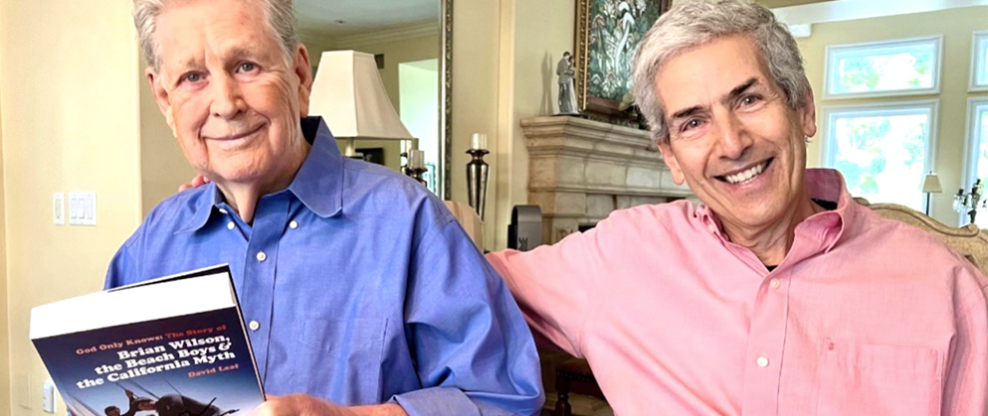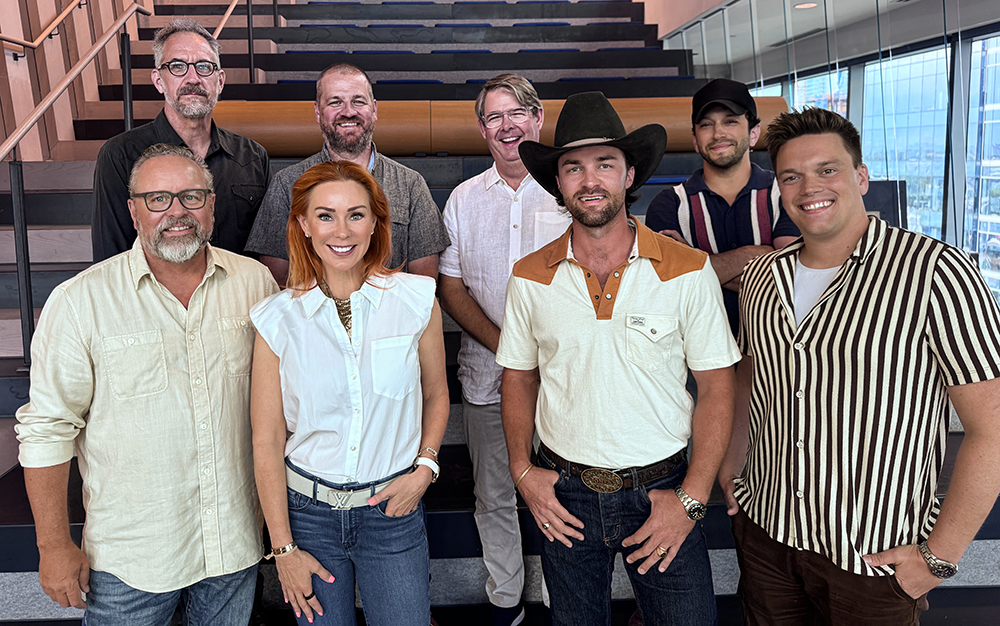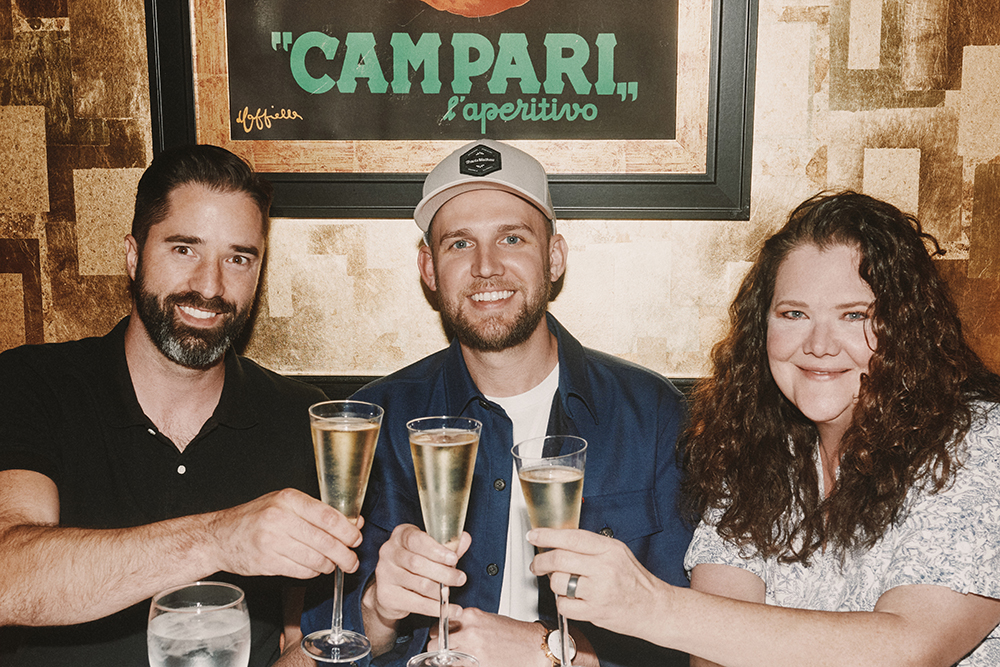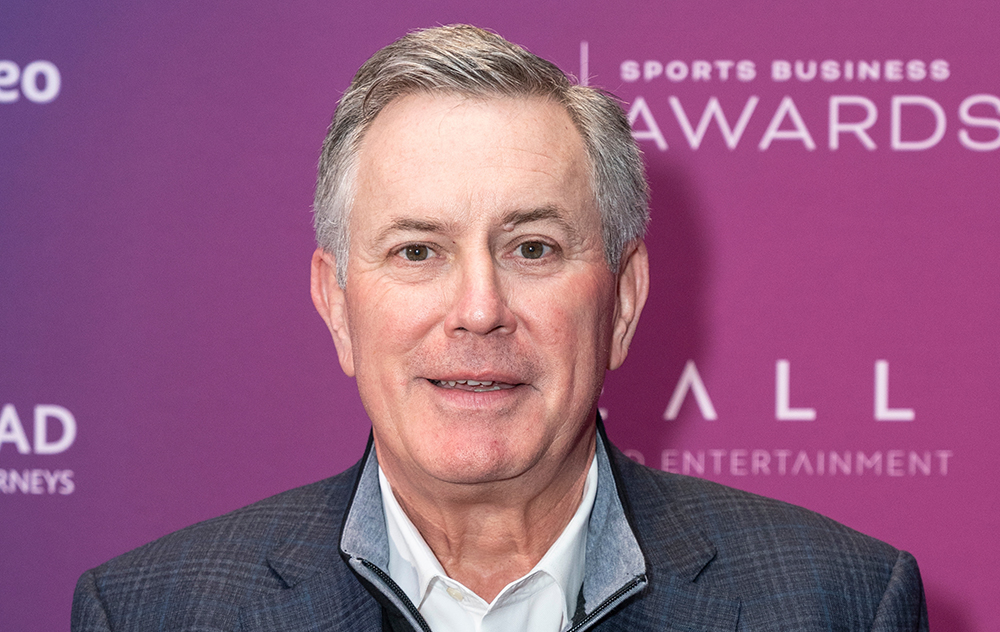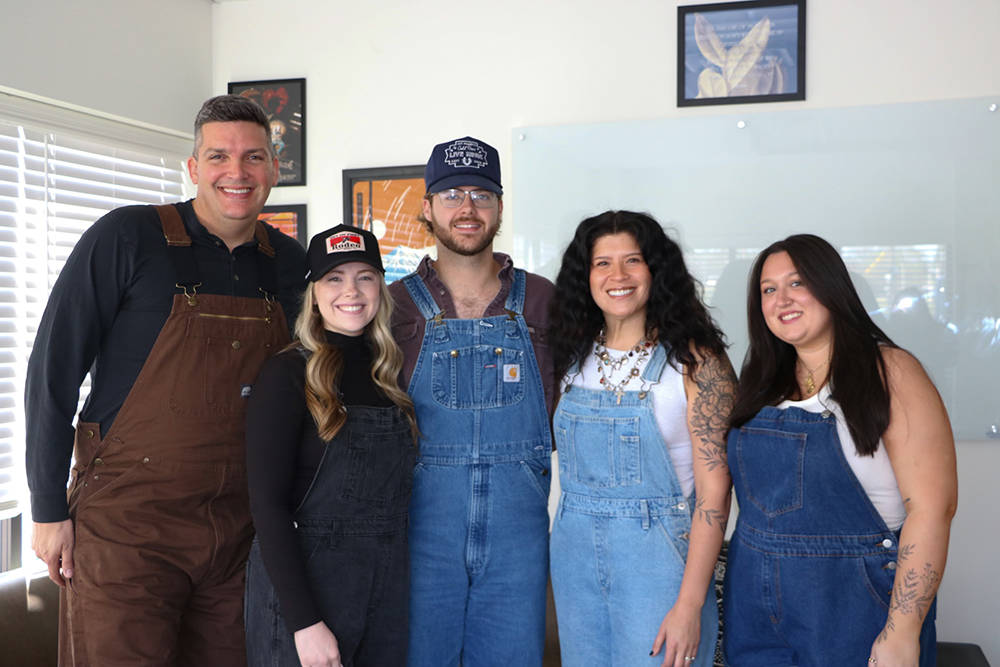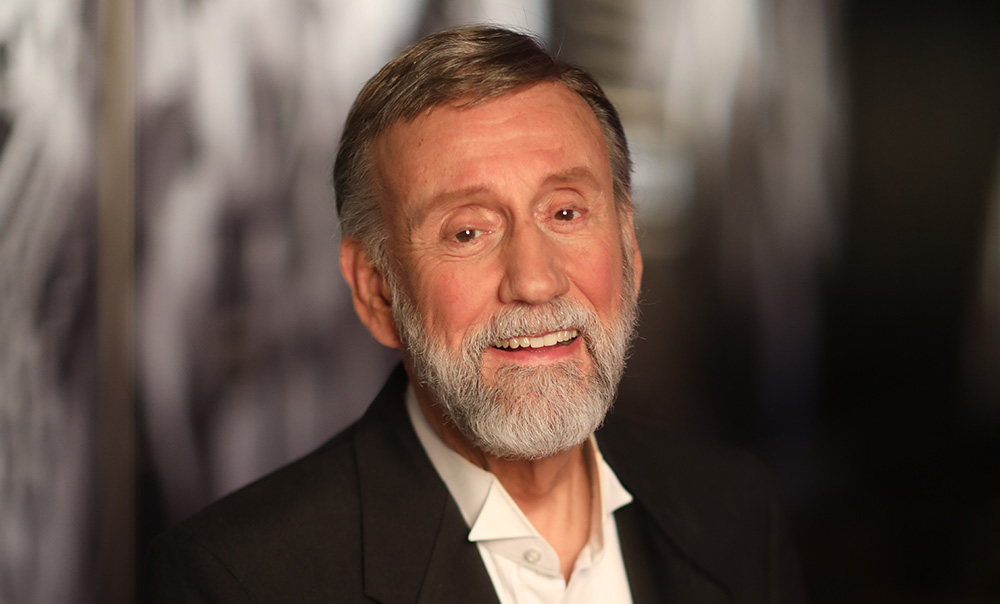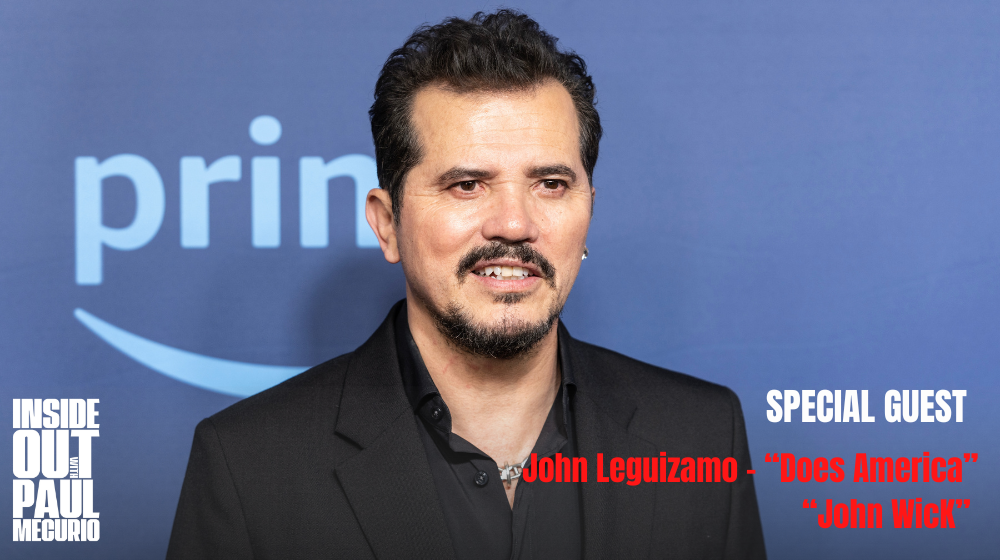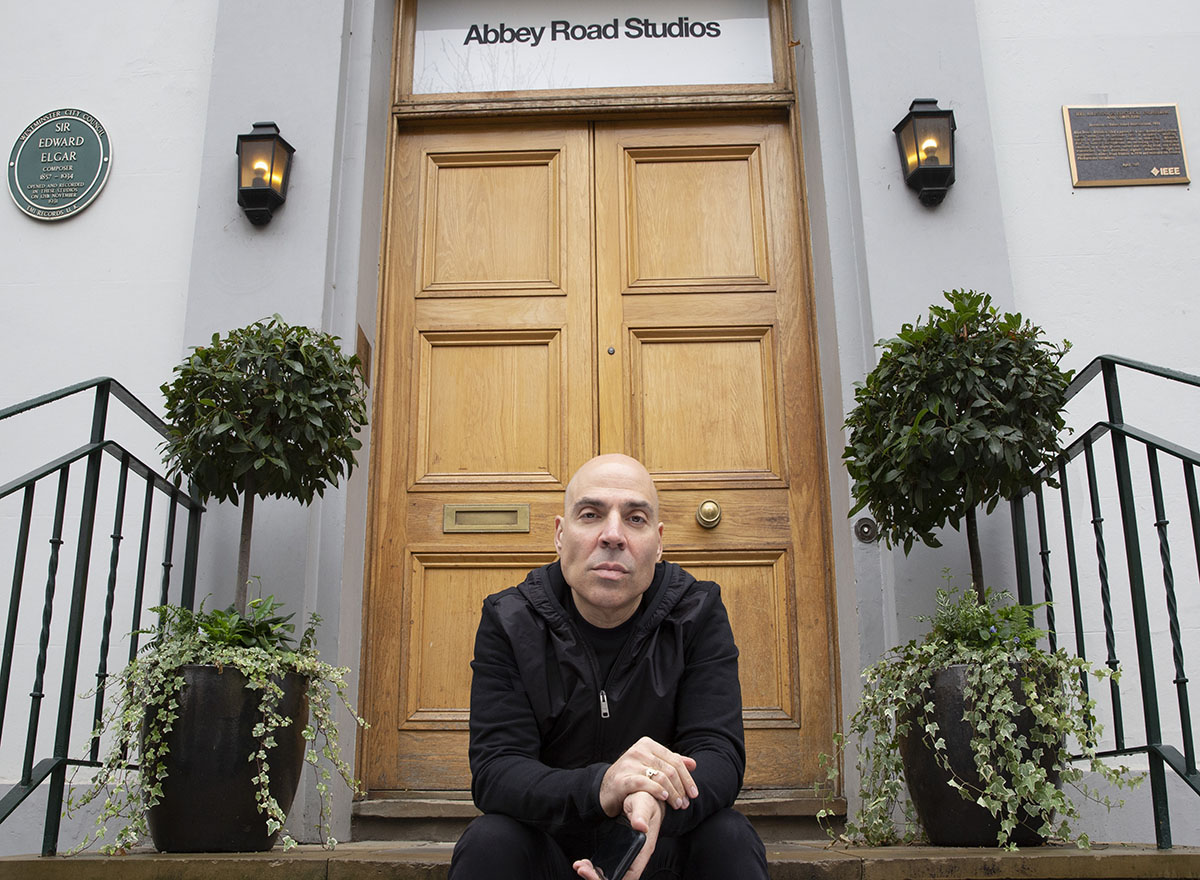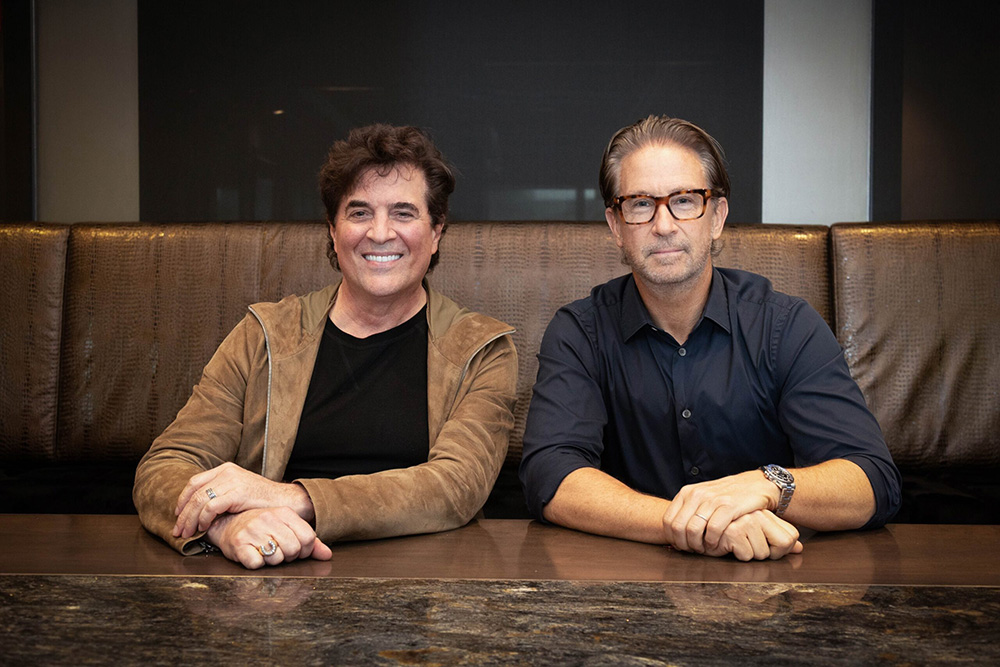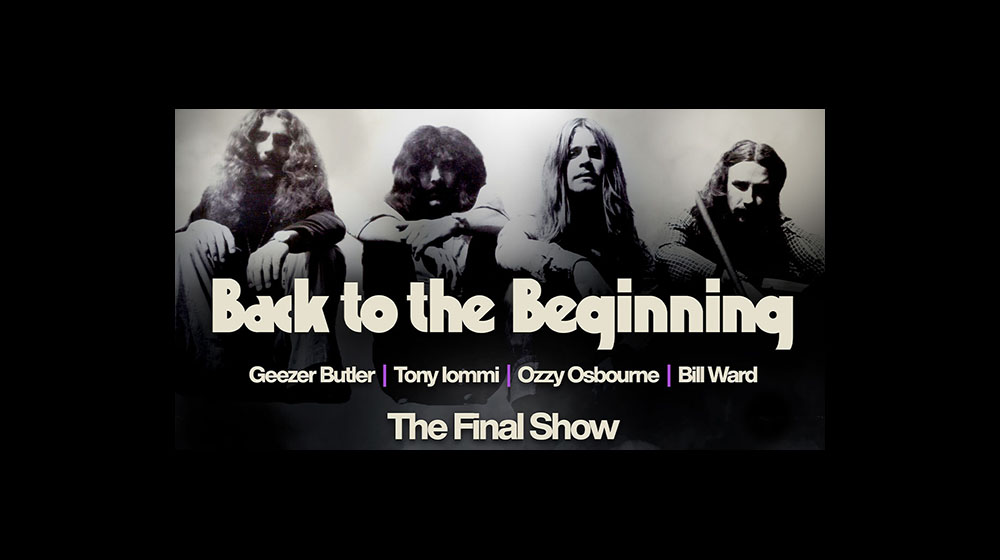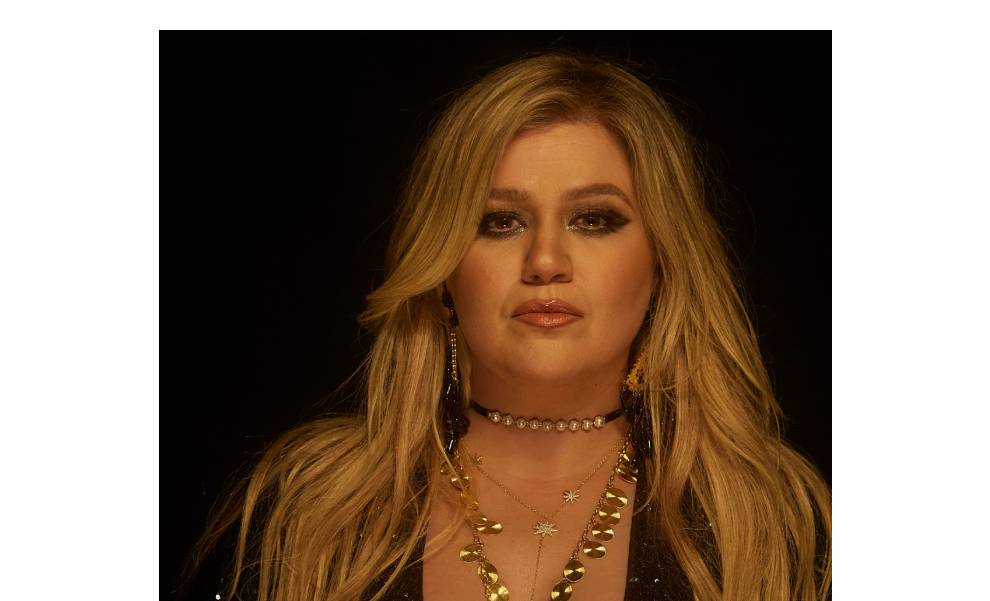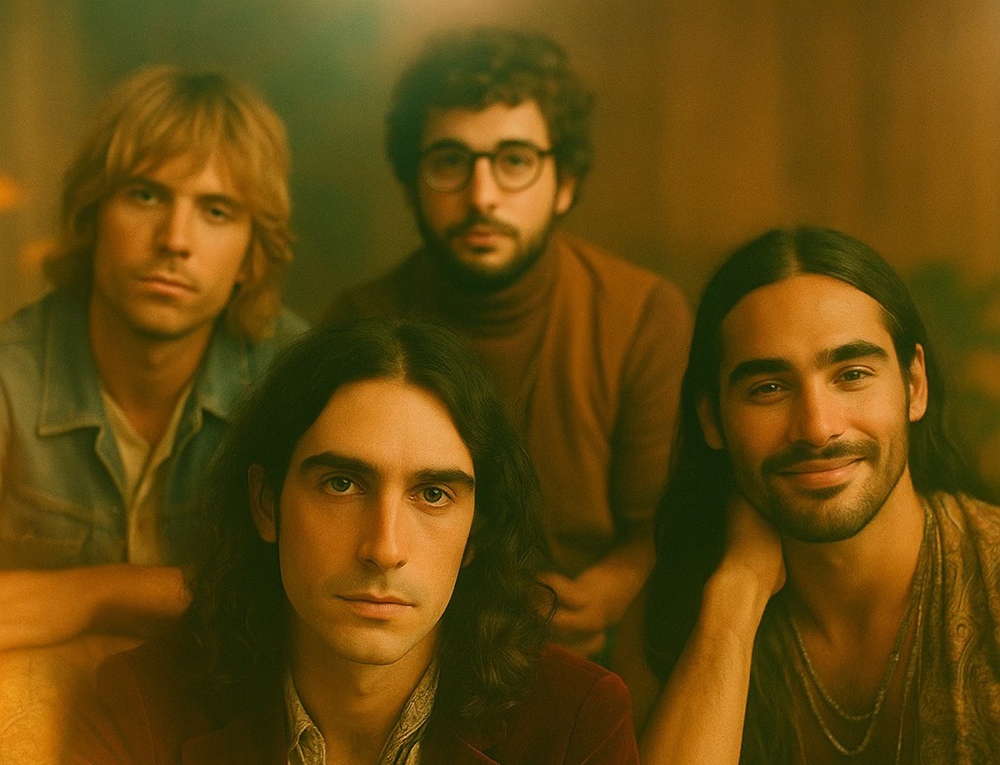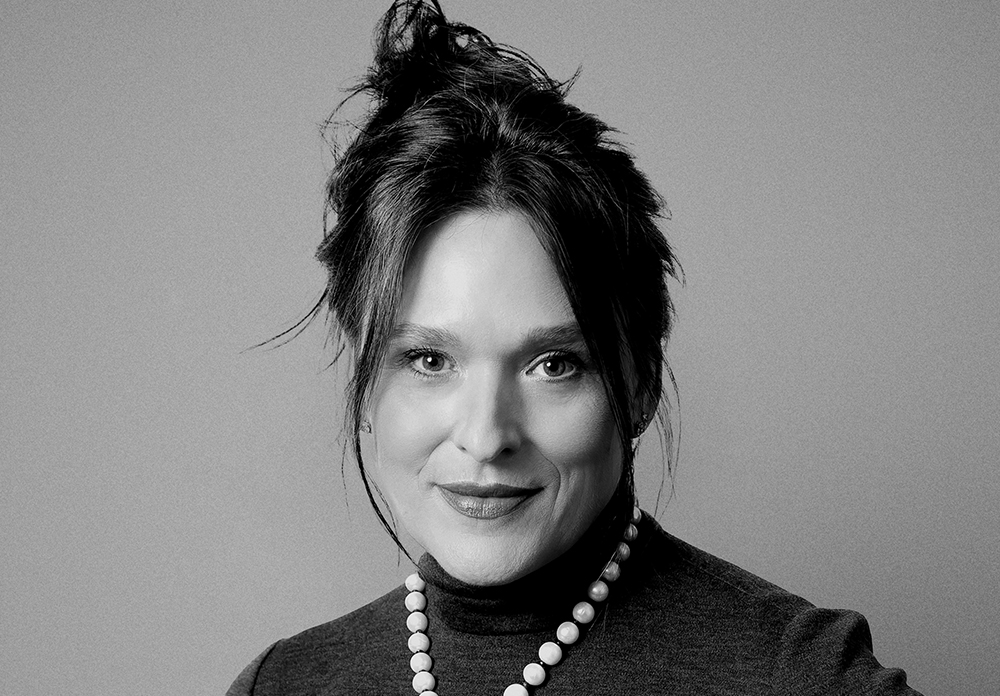This week In the Hot Seat with Larry LeBlanc: David Leaf, writer, director, and producer.
This is the story of David Leaf.
It is also a story of Brian Wilson.
Los Angeles-based Leaf–a Peabody and WGAW award-winner–has spent almost five decades being around the legendary Beach Boys’ master tunesmith, writing about Brian and his music, thinking about Brian, talking about Brian, and telling us the inside story of Brian’s extraordinary life, and times.
“For over thirty years I’ve trusted David Leaf with my music and my story,” says Wilson. “The 2001 Radio City tribute to me was a highlight of my career. And his ‘SMiLE’ film ‘Beautiful Dreamer’ was one of the reasons I was able to finally finish the record. He’s a true friend.”
A highly successful TV writer, producer, and film director, Leaf has been involved in an extraordinarily extensive list of television and film documentaries.
Among Leaf’s documentary film production credits are “The Night James Brown Saved Boston,” “The U.S. Vs. John Lennon,” “Who Is Harry Nilsson (And Why Is Everybody Talkin’ About Him),” “Beautiful Dreamer: Brian Wilson and the Story of SMiLE,” and the fine Bee Gees’ documentary, “This Is Where I Came In.”
Most recently, Leaf directed the upcoming Dion DiMucci documentary “Born To Cry” to be released in 2023, and he wrote, produced, and directed “To Tell The Truth,” a film about the WWII Japanese internment camps.
He also wrote and produced TNT’s “An All-Star Tribute To Brian Wilson.”
As an author, Leaf is best known for his groundbreaking 1978 book “The Beach Boys and the California Myth” which was updated in 1985 and expanded this year with the title changed to “God Only Knows: The Story of Brian Wilson, The Beach Boys & the California Myth.”
It’s a must-read for anybody interested in either music journalism or contemporary pop music.
Since 2010, as an adjunct professor, Leaf has taught undergraduate music courses at the UCLA Herb Alpert School of Music in Los Angeles.
Your first book, “The Beach Boys and the California Myth,” was published 44 years ago in 1978. That 192-page book has been updated, expanded, and its title changed to “God Only Knows: The Story of Brian Wilson, The Beach Boys & the California Myth.”
You initially had wanted to reissue the original book with an anthology of your writing about Brian Wilson and the Beach Boys since the 1985 edition.
A new edition then would have included your college newspaper reviews, articles from Pet Sounds magazine, the press kit for Brian’s first album in 1988, liner notes for “Twofer” Beach Boys’ releases (1990), and from the box sets “Good Vibrations” (1993), and “The Pet Sounds Sessions” (1997), tour program essays, and your full interviews for the fine documentary film, “Beautiful Dreamer: Brian Wilson and the Story of SMILE” (2004).
Omnibus Press, however, regarded the original edition as historically notable. So this expanded 469-page new edition is essentially unchanged except for two new bookend pieces covering the decades since the 1985 edition.
“The Beach Boys and the California Myth,” originally came out with Grosset & Dunlap in ’78, and the rights reverted back. I emailed David Barraclough, editor-in-chief of Omnibus, and we got on the phone, and I told him what I wanted to do which was to take the old book and bookend it with everything that I had written about the Beach Boys before that book, and everything that I had written afterward, including the books in the box sets, the liner notes, and tour programs, and all that. He said, “We aren’t interested in an anthology.” He said, “We’d love to bring your book out if you’d do an update.” I really wasn’t thinking about doing an update. I felt that I had almost been updating the book in real-time.
You hadn’t gone back, and re-read the original book over the years?
I hadn’t read the original book; I’d say in 20 years. It might have been 30 or 35 years. There was no reason for me to read the original book.
I love the late Tom Petty saying to you at the side of a stage at an award show, “Great book, man.”
That was bizarre. I was there because Timothy White (the late editor-in-chief of Billboard) had hired me to work on the Billboard Awards.
You started writing about Brian Wilson and the Beach Boys as an outsider.
Absolutely.
After the 1985 edition of the book, you were admitted as an insider with Brian to the point that your wife Eva was a bridesmaid, and you an usher when Brian and his wife Melinda married in 1995, and you both became godparents to their oldest child, Daria Rose.
Under those circumstances, you can hardly be expected to keep your objectivity. It has to have been blown out the window. The point I’m making is that you are no longer a journalist writing about Brian Wilson, You are a voyeurof sorts.
Well, I am a fly on the wall. What I am trying to share with the reader are stories that they can’t get anywhere else. We can go to Wikipedia now. We can get the details of every single event in the history of the Beach Boys or Brian Wilson’s solo career. We can see names, dates, places, (chart) numbers, and who played on what.
It’s all there.
What can I give the reader that they couldn’t get anywhere else? And the answer is experiences that I’ve had with Brian Wilson that give the reader an insight into the kind of person that he is. He’s an unbelievably sweet guy. He doesn’t have a mean bone in his body. He doesn’t have an ironic bone in his body. He means everything that he puts into his music because it (his music) is all coming from his heart.
Am I objective?
I don’t know what the right word for it is, but I am telling my truth. That is my truth. I have been called a Brianista. Well, okay. Sir George Martin, Sir Paul McCartney, Sir Elton John, Sir Barry Gibb, and 500 more of the greatest musicians of our time all think that Brian Wilson is a genius. I think that I will be on their side.
So yeah, it’s not being objective in a traditional journalistic sense. I’m not sure that the original book was traditional journalism either. I started out as a journalist, but by the time I had spoken with all of the people that had been around Brian, who had worked with Brian, who knew him, it was tough not to tell the story that I did, which was what happened to this guy who made everybody so happy with his music.
In the early ‘60s, the Beach Boys were one of America’s leading musical acts. A significant cultural force because their music captured California teenage life while defining both the emotions of Brian’s character and the band members’ social attitudes.
Why do the Beach Boys matter anymore? Why are the Beach Boys still relevant today?
Although a version of the band still tours. they haven’t had a Top 40 hit since “Kokomo” from the 1988 film “Cocktail,” and the 1989 album “Still Cruisin’” Written by Mike Love, John Phillips, Scott McKenzie, and Terry Melcher, it was the band’s first original Top 20 single in 20 years and their first #1 hit in 22 years.
Is the band and its music a nostalgia play in that when we think of summer, girls, cars, and California, we think of the Beach Boys, and our teenage years?
Certainly, for those of the boomer generation for sure.
In essence, The Beach Boys have the copyright on “Summer.”
(Laughing) That’s a good way to put it. I love that.
So why are the Beach Boys relevant today?
There are two answers to your question. One is, like all legacy acts, there is an audience who wants to go and hear these couple of great hits, and feel young. The music makes you feel young. There’s no question about it. The touring Beach Boys have a great band, and they do a terrific job of bringing that music to people.
As the group’s frontman Mike Love gained exclusive license to tour as the Beach Boys, he transformed it into “America’s Band,” a politically conservative oldies act.
The touring Beach Boys in my opinion aren’t relevant. They are just like every other legacy act out there churning out the hits and have been doing so ever since the album “Endless Summer” came out in ’74. So the reason they are relevant in today’s world is “Pet Sounds” (1966), and the legend of Brian Wilson.
So, Brian’s music being passed down answers the question of why the Beach Boys are relevant?
And that is what I really focus on in the book, talking about who is this artist? Where did he come from? How did he do what he did? What were the challenges that he faced? What was the rollercoaster of his life as it relates to the creation of this music? What were the roadblocks that he hit? How did Capitol Records demolish “Pet Sounds?” How did the internal conflict of the Beach Boys affect him?
The reason to read this update is that it is now a redemption story. The first book did not end happily. The brief update in 1985 had a little hope in it, but it was not a happy ending either. Now we can look back from this vantage point, and say, “What a miracle that this guy survived, came out of the darkness, and gave us a Hall of Fame career all on his own. The most unlikely ending to this story was him making great solo albums, going out on tour, finishing “SMiLE,” presenting it, and doing “Pet Sounds” tours. And because “Pet Sounds” is so relevant. Every generation that comes along everybody goes through those teenage years, all of that teenage angst, all the feelings of, “Do I belong? Where do I fit in? What am I going to do (with my life)?”
But more than that, The reason that his music remains relevant is that you don’t have to speak English to love the Beach Boys. And the reason that I say that is that he put feeling into his music. On his very first tour of Japan in the summer of ’99, this lovely Japanese man came up to Brian and said, “Your music makes my heart soar.” He hardly spoke any English. So he didn’t know about cars and surfing and all that stuff. What he knew was how the music made him feel, and that’s why they are relevant.
I quite appreciate in the new book the celebrities praising Brian, including, Sir Paul McCartney, Burt Bacharach, David Crosby, Neil Young, Peter Townshend, Roger Daltry, Stevie Wonder, Paul Simon, Art Garfunkel, Jimmy Page and Randy Newman. Also Jimmy Webb’s “All I Know” introduction is spell-binding
It was pretty thrilling. Jimmy wrote something like, “I love reading what David writes about Brian almost as much as I love listening to Brian’s music.” He’s such a great guy. He’s probably the most underrated artist of this generation. His words and music are just brilliant.
Jimmy’s autobiography, “The Cake and the Rain: A Memoir” (2017) is a must-read for anyone interested in contemporary pop music.
Bob Dylan had the best quote. “Jesus, that ear. He should donate it to the Smithsonian.”
Dylan’s quote is pretty great. I put all that stuff (quotes) in the book because back in the day you just couldn’t Google, “What are people saying about Brian Wilson?” And see all of this stuff. Over the years I’ve been able to get comments firsthand sometimes. Or I’ve seen them in documentaries. When Sir George Martin said to me. “’Sgt. Pepper’s Lonely Hearts Club Band’ was our attempt (by the Beatles) to equal ‘Pet Sounds,” I was, to use the British word, gobsmacked. It was like, “Whoa!”
In the ‘60s, artists didn’t talk about other musicians unless it was on BBC Television’s “Juke Box Jury” peak-time show or in a review column in Melody Maker, New Musical Express, Disc & Music Echo, or Sounds.
They did amongst themselves.
But not often in the music media unless there was a discussion of Bob Dylan.
There really was no music media (in the U.S.). In England there was. There was a tremendous amount of media.
In 1968, Paul McCartney was asked to name his favorite songwriter. His answer was “Nilsson.” When asked to name his favorite group, he gave the same answer, “Nilsson.” Harry Nilsson then was mostly unknown, still working at a bank while writing songs at RCA’s Hollywood office. Being declared a favorite by McCartney and other Beatles members had a profound impact on his life.
Brian Wilson being a genius was certainly discussed in the British music papers in 1966 and 1987.
The reason it came up in ’66 was (due to publicist) Derek Taylor, and you saw quotes about “Pet Sounds” in 1966 in which Eric Clapton is saying, “Brian Wilson is a pop genius,” and Pete Townshend, I’m sure much to his regret, is saying it’s “sickly sweet” or something like that.
Asked about “Pet Sounds” by Disc & Music Echo magazine, Pete Townshend attacked Brian for making pop music too complex. He said, “Brian Wilson lives in a world of flowers and strawberry-flavored chewing gum. His world has nothing to do with pop. Pop is going out on the road, getting drunk, and meeting the kids. ‘Good Vibrations’ was probably a good record but who’s to know? You have to play it about 90 bloody times to even hear what they were singing about.”
By 2016, Pete had changed his view, and as you quoted in the new book, he said, “I love Brian, I love him, you know there aren’t many people I’d say that about, and I think he’s a truly, truly, truly, a great genius.”
He’s changed. I was at the Bridge School benefit in the Fall of 1999 with Brian, and I watched his set from the side of the stage, standing between Neil Young, and Pete Townshend. You want to talk about an experience. They were watching with just disbelief. This guy (Brian) was dead and buried a number of times, and there he was not only just playing great with a terrific band but directing the show. It was an all-acoustic set. And Brian said to the band off mic to do “Good Vibrations.” And Neil said to me, “What’s going on?” And I said, “He wants to do ‘Good Vibrations’ but they didn’t rehearse it acoustic.” Then when Brian says into the microphone, “You guys want some good vibrations?” Of course, 20,000 or 30,000 people roared, and Neil said, “I love it, man. He’s still out there.” And that is what artists respect. They respect that Brian Wilson is still Brian Wilson regardless of all of the trials and tribulations. He is still that guy.
Originating out of the Beach Boys’ 1966-1967 publicity campaign following upon the collapse of “SMILE,” and the release of “Pet Sounds” ushering in a new approach to album making that was said would revolutionize pop music, was the hypothesis that a non-touring Brian Wilson was a genius. The phrase originated with Derek Taylor, the former Beatles press officer who had moved to Los Angeles in 1965, and that perception has overshadowed Brian Wilson and the band ever since.
Many of us from the ‘70s era of music writing are New Journalism offspring of author Tom Wolfe as well as pioneering music journalist Paul Williams, founder of Crawdaddy magazine.
Among the other American rock journalists with original voices from that era were Richard Goldstein, Lenny Kaye, Michael Lydon, Nick Tosches, Jon Landau, Lester Bangs, John Rockwell, Bud Scoppa, Dave Marsh, Robert Christgau, Kurt Loder, Ben Fong-Torres, and Greil Marcus.
Were any of these an influence?
I was so, I guess naive is the right word, I didn’t know that you could read about music.
Back then, there were such music-based publications as Hit Parader, Circus, Cheetah, Jazz & Pop, Rolling Stone, Crawdaddy, Creem, and New York Rocker and newsweeklies The Boston Phoenix, Good Times, and The Village Voice for the coverage of pop and rock music.
I didn’t buy anything. I just heard records on the radio and bought a few singles. I was a Beatlemaniac in the Sixties. In the Fall of 1971, there was a record store near my dorm in college called Record City, and as I was checking out there was a pile of magazines on the counter, and the Beach Boys were on the cover. I pointed to the magazine, and I asked the clerk, “What’s that?” And he said, “It’s Rolling Stone. How could you possibly not know what Rolling Stone is?” Anyway, I bought it, and there was this massive article by Tom Nolan and David Felton (“The Beach Boys: Part One of A California Saga,” Rolling Stone, Issue 94, Oct. 28, 1971).
The story was a two-parter that also ran in the follow-up issue. The pair of stories focused on the band’s internal dynamics and history, particularly discussing how the Beach Boys were out of step with the era.
And that is what began to turn me from being a casual Beach Boys’ fan into a journalist with a mission to tell Brian Wilson’s story..
You went on to become the music editor at the George Washington University Hatchet.
I was the music editor of The Hatchet which was a department of one. I started writing record reviews. I had never written about music prior to reading that Rolling Stone article. I was a sports writer. When I read that Rolling Stone article I bought the “Surf’s Up” album (1971). I heard that the song “Surf’s Up” (a song originally intended for the Beach Boys’ unfinished album “SMILE”) that Tom talked about in the article. And the song. “’Til I Died.” before it on the “Surf’s Up” album (written by Brian) was as beautiful as anything that I had ever heard. So I said, “Oh my goodness, Brian Wilson still has his talent intact.”
I read the article, and I saw the Beach Boys in concert at Georgetown University. It was a stunning show. Two-and-a-half hours or so. My roommate and I talked about it. We became obsessed with the Beach Boys and very early on, I was still in college I kind of verbalized, “I’m going to move to California, and write a book about Brian Wilson, become his friend, and help him finish “SMILE.”
That was in 1971 as the Beach Boys were trying to revamp their image and restore their public reputation following the dismal reception to their past reissues, and the albums “20/20,” Smiley Smile,” Wild Honey,” Friends,” and “Sunflower” and tours.
I remember them appearing in a series of commercials with the tagline “It’s now safe to listen to the Beach Boys.” And the band played the Fillmore East with the Grateful Dead, and performed at the Big Sur Festival in late 1970 and reportedly “just blew everyone’s mind with a stellar, energetic set that had everyone dancing and singing along.”
Derek Taylor’s “Brian Wilson is a genius” campaign of 1966 attracted a hip group of collaborators around the Beach Boys, including Van Dyke Parks, who became Brian’s collaborator on “SMiLE,” and his manager, David Anderle, who came to head Brother Records, the new record company formed by the Beach Boys.
Eventually, while it was conceded that few could match Brian’s technical innovation, lyrical depth, or melodic genius, few cared about Brian and the Beach Boys by the ‘70s. They were close to being forgotten about.
When you wrote the book you were 25, intense, and quite driven. It was like you were trying to yell out to the world, “You gotta pay attention to Brian Wilson.”
I was going into journalism, and I had read about (American radio and television news broadcasting pioneer) Edward R. Murrow, and it was like, “Oh, you can tell a story and make a difference.” I took it upon myself that my mission was going to be kind of grab the world by the collar and say, “Hey, you’ve got to pay attention to this Brian Wilson guy. He’s really important.” That is what was behind my moving to California, and starting a fanzine called Pet Sounds that led to my first book deal back then.
I have some back issues of Pet Sounds.
Oh my goodness. They are collectors’ items.
In Pet Sounds you could be highly critical of the Beach Boys at times. Not many people then critiqued the group at the time. They were either dismissed or ignored.
As a fan, I wanted them to be better than they were. After “Holland” (1973) we kept waiting for the new Beach Boys’ album, and when it came out it was “15 Big Ones.”
Following “Holland” the Beach Boys focused on touring to capitalize on the unexpected success of “Endless Summer” (1974). their greatest hits compilation. They attempted to record a new album at Caribou Ranch studio in late 1974, but sessions were halted.
“15 Big Ones” received dismal reviews. “What the little deuce coupe is goin’ on round here?” asked the New Musical Express. “It all adds up to a compulsive, tentative album that almost sounds unfinished,” wrote Jim Miller of Rolling Stone.
Most of “15 Big Ones” was hastily recorded in early 1976 at the band’s Brother Studios in Santa Monica with sessions marred by internal group strife and the interference of Brian’s therapist Eugene Landy.
Nevertheless, to highlight Brian’s recovery, and his return to writing, a promotional campaign with the tagline “Brian Is Back!” led to supportive stories in music mags Rolling Stone, and Crawdaddy as well as such mainstream media outlets as Newsweek, New West, the New York Times, and the Los Angeles Times.
“15 Big Ones” was released in the year of the so-called “Brian is Back.” It had some new songs and had them covering some oldies. It was like, “This is what we have been waiting three years for?” So as a fan I was disappointed and critical. Otherwise, what was the value of writing about it? Just to say everything they were doing was great just seemed pointless and stupid.
The first Beach Boy you met was Dennis when you got to Los Angeles. You ran into him on the street. and you said that you were going to write a book and collaborate with Brian and he basically said, “Good luck.”
I wasn’t in California 36 hours before I crossed the street at Fifth and Broadway, and walking north walking toward me was Dennis Wilson. I didn’t realize that he was going into the Brothers Studio (at 1454 5th St, in Santa Monica). I walked up to him, and I was never shy, and I said, “Hi Dennis. My name is David Leaf. I just moved to California to write a book about your brother Brian.” And he laughed. I can still hear the echo of the laugh. And he said, “Good luck.” Because it was too preposterous.
What is even more amazing in retrospect is that in 1971 I had met Mike Love after this concert that I went to at Georgetown University. it was right after I had read the two-part story in Rolling Stone. So I was a convert to the Beach Boys. I was a convert to the myth of “SMILE.” I was on crutches because I was about to have leg surgery and I was with an R.A. (resident assistant) from my dorm, Bob Brown, and we were waiting for a ride back to George Washington University, and he said to me “Look.” I turned and Mike Love was standing right next to me. I started bombarding him with questions. And he knows how to deal with fans. After a while he said, “I’m going to answer all of your questions in my autobiography.” That was in 1971. That book didn’t come out for 45 years.
“Good Vibrations: My Life as a Beach Boy,” by Mike Love James S. Hirsch was published in 2016 and timed to coincide with the 50th anniversary of “Good Vibrations.”
You have spent much of your life writing about the Beach Boys through the lens of Brian Wilson. With the original edition of the book and its 1985 follow-up, there were concerns voiced by Mike Love of being marginalized by what you were writing.
Most everything you write about the Beach Boys is from the perspective of Brian Wilson.
But what else matters?
If you are Mike Love, Mike Love matters. He wrote his autobiography as a response to “many inaccuracies” that had been said about him over the decades. Much of the book covers his 1992 lawsuit against Brian Wilson for alleged owed songwriting credits. There’s no question that he could turn a phrase and knew what made a good lyric. He deserves recognition.
Well okay, and he does. It is just not something that I want to write a book about.
Do you have any kind of relationship with Mike Love today?
(Laughing) I think the best way to answer that question is that Mike Love doesn’t like me. He made that clear in his autobiography. When I started work on this edition of “God Only Knows” I had not read Mike’s book or Brian’s autobiography. I got them both, and I read them, and I think they are extremely reflective of the individuals, and that’s valuable. I think when you know the truth, and you read something else, you ask, “Why is he writing that?”
Brian was intensely competitive in the band’s early years, Mike is so often reviled by journalists, and by the music industry community, but he was one of the most productive collaborators Brian has ever had.
I would say his most successful collaborator. I would argue that Roger Christian (then DJ at Los Angeles radio station KFWB) with a song like “Don’t Worry Baby” (as well as “Shut Down,” and “Little Deuce Coupe”) or Tony Asher with “God Only Knows,” or Van Dyke Parks with “Surf’s Up,” and “Heroes & Villains,” and (fellow musician) Gary Usher with “In My Room” were also important.
Tony Asher, a copywriter at the Carson-Scott advertising agency, had written campaigns for Mattel toys (“You can tell it’s Mattel – It’s swell!”), as well as Max Factor, Gallo Wines, and other high-profile clients. He might have been a more formidable collaborator if he had stayed around.
Brian was the chief source of whatever was going to happen, and he proved over and over that he wrote great songs. He wrote great songs with Russ Titeleman including “Guess I’m Dumb” which Glen Campbell recorded in 1965, and “Sheri, She Needs Me” (also known as “Sandy” or “Sandy She Needs Me,” rewritten by Carole Bayer Sager, and renamed “She Says That She Needs Me.” and issued on Brian’s 1998 album “Imagination.”)
He even wrote a great song “Breakaway” (1969) that his father apparently co-wrote (credited to Brian Wilson and “Reggie Dunbar,” a pseudonym for Brian, Dennis, and Carl’s father, Murry Wilson). He wrote “Surfer Girl: by himself. So Brian didn’t need any help. He wrote “Surf City” and gave it to Jan & Dean to finish. So he had what mattered which was the melody and the composition, the arrangement, and the hook. He was the guy. Mike certainly had an ability to rhyme and write about cars and girls and surf and fun. “The Warmth of the Sun” is a beautiful, beautiful piece (released on the Beach Boys’1964 album “Shut Down Volume 2,” and as the B-side of the “Dance, Dance, Dance” single). But Brian is the guy.
You’ve been asked, “What’s the difference between the Beatles and the Beach Boys?” Of course, the central theme in the Beach Boys’ saga is Brian’s loyalty to his family, and to the group, all of whom feared any deviation from the successful hit-making formula Brian had developed through his productions.
There are a lot of things. Maybe, it is as simple as that in 1962 Brian Epstein became the Beatles’ manager, and Brian, Dennis, and Carl’s father Murry Wilson became the Beach Boys’ manager, and it was a small family business. It wasn’t run with a vision. Brian Epstein was sophisticated. He was smart, and he was connected. He saw the world. The Beach Boys remained a Southern California business. The music spread to the world, but it was not a sophisticated operation so to speak.
Working as their manager until 1964, when he was ousted by Brian, Murry, an aspiring pop musician himself who had made contacts in the music business in the 1950s, provided the Beach Boys with the initial guidance they needed to make their first few big breaks.
However, it was Murry in 1969 who sold the copyrights to nearly all of the songs Brian had written for only $700,000 to Irving-Almo, the publishing division of A&M Records. Though no longer the band’s manager Murry had retained control over its publishing company, Sea of Tunes. Brian was devastated by the sale.
You had a hidden insider for your original book, Brian, Dennis, and Carl’s mother Audree, whom you extensively interviewed.
I sure did. Some of the things she told me, she said I could quote her on, but other things were, “Don’t quote me.”
I love the story of Dennis telephoning you in the middle of the night asking, “Where did you get that story?” You said, “I can’t tell you.” Dennis continued, “You have to tell me.” Then you said, “It was your mom.” Dennis laughed, and said, “Why would you listen to her?” Then you both started laughing.
One of the great laughs of all time.
There are stories of the first few Beach Boys’ live shows in Southern California where the band members weren’t too sure how to use their instruments.
If you listen to the first album there doesn’t seem to be any reason to doubt those stories.
What was the problem with Nick Venet? As well as being a producer, he was head of A&R at Capitol, and he was quickly jettisoned as the Beach Boys’ producer in favor of Brian.
Nick Venet signed the Beach Boys to Capitol when no other label would sign them. Well, the way the system worked was the A&R guy was the house producer. You went into the studio, and you had the guy there. After a while with Murry being the bully that could get things done, it was like, “Let us make the records elsewhere, nd we will will make hits for you.” Nick Venet, in my experience, was not a villain. He was a 25-year-old A&R guy who heard it (their music) and said, “That’s a hit.” Good for him.
Nick Venet began his career at age 19 with World Pacific Jazz working with such notables as Chet Baker, Lord Buckley, Nat “King” Cole, Stan Getz, Chico Hamilton, Stan Kenton, at Lambert, Hendricks, and Ross At 21, he joined Capitol Records and would produce the Kingston Trio, Glen Campbell, Jim, and Ingrid Croce, Bobby Darin, Les McCann, Fred Neil, Lou Rawls, John Stewart, the Stone Poneys.
The Brian Wilson story you and others have told is almost like the Kardashian saga of family and group turmoil which continued for years.
Well, the brothers weren’t feuding so much. Dennis was just living a strange life that I had to touch upon in the book, and ignore the fact who he ended up living with.
Charles Manson.
Right. There was also the hiring of this weird psychologist for Brian and all of the psychodrama that entailed. The rehiring of this weird psychologist. Dr. (Eugene) Landy did two things that nobody could imagine. He saved Brian’s life. Brian was really in a downward spiral in 1982, when Landy was brought back. The other thing that happened was that the Beach Boys hired Landy, and it was Landy that took Brian solo. It took someone like that. someone with that kind of ego, and “I don’t care about you and your business, Brian Wilson solo is better for my business.”
Brian Wilson became a patient of Eugene Landy, known for his unconventional 24-hour therapy and treatment of celebrity clients, in 1975. Landy was discharged within a year, but returned as Brian’s therapist, subsequently becoming his executive producer and business adviser. Landy negotiated an executive producer credit, and several writer credits on Brian’s debut solo album, “Brian Wilson” (1988), and acted as Brian’s business partner until a 1992 restraining order barred him from contacting him.
Landy was credited with co-writing songs with Brian.
Well, he was, and fortunately a lot of his lyrics ended up getting thrown off the finished masters. He and his girlfriend wrote lyrics, as Russ Titleman has said, that “were like third-rate greeting card lyrics.” So there was an awful lot of drama around. It could have been a reality show. In fact, during “Landy Volume Two,” he had his goons videotaping everything Brian did morning, noon, and night, so there was a record of it.
One of Brian’s favorite Beach Boys’ original songs is “Do It Again” released as a single in 1968. Written by Brian and Mike, it is a self-conscious callback to the group’s surf days. It subsequently appeared as the opening track on the Beach Boys’ 1969 album “20/20.”
Well, that was a return to the Beach Boys. But if you listen to “20/20,” one of Brian’s contributions was an amazing song called “Time To Get Alone.” “I’m done with this. I’m walking away from this.” When Brian wrote songs where he wrote the lyrics, he always said what he meant. With “Til I Die,” and “Love & Mercy,” he really had a way of expressing himself lyrically that was terrific.
I was in one of the RCA Hollywood Studios in 1969, and an orchestra was assembled for a Beach Boys’ track. Brian wasn’t there. The session ended, and the same musicians then did backing for a track by Gary Puckett & The Union Gap. These seasoned middle-aged horn and string players were playing parts without caring who the band was.
I don’t know what that was a session for, but Brian had begun using session players after observing Phil Spector at work.
Los Angeles has forever been a company and a studio town. But in the ‘60s, it became the center of the music universe, as a generation of music managers, label executives, and musicians seduced by Southern California’s sun-drenched lifestyle, became convinced that their futures lay in the City of Angels.
America’s music industry transitioned away from New York to Los Angeles as the music business rebounded with new L.A.-based labels like A&M, Elektra, Dunhill, Straight, and Reprise joining Dot, Keen, Del-Fi, Modern/Crown, Specialty, and Liberty.
And there were an abundance of studios in Los Angeles, including Gold Star, Western, Crystal Sound, TTG, Wally Heider, Record One, RCA, TTG, Kendun, Elektra, American Recording, Amigo, Grandmaster Recorders, and others. And clubs like Pandora’s Box, the Whisky A Go Go, Ciro’s, the Hullabaloo Gazzarri’s, The Trip, London Fog, The Fifth Estate, The Ash Grove, and The Troubadour.
And a great body of new talent including the Beach Boys, Jan & Dean, Sam Cooke, Herb Alpert & the Tijuana Brass, Ike and Tina Turner, and later the Doors, the Byrds, Love, Steppenwolf, Three Dog Night, the Mamas & the Papas, Buffalo Springfield, and the Mothers of Invention.
What labels like A&M did was say to their artists, “We believe in you. Go in and make the best records that you can. And if it’s not a hit we’ll make another record.”
Elektra too.
Yes. And that business is gone. Growing up in New York I loved Dion and the Rascals. There were a lot of great groups in New York. But L.A was the golden place. It just was.
Yes, convertibles, palm trees, surfboards, and transistor radios blaring, all advertised a post-war optimism.
As Van Gordon Sauter wrote in the 2018 book “Tales From the Strip: A Century in the Fast Lane” with Gordon Landau, “The Strip of the 1960s brought a new genre of American music to the masses. “Although rock ‘n’ roll first appeared in the fifties, introduced by such artists as Elvis Presley and Buddy Holly, a decade later Sunset Strip musicians drove the form into the mainstream of American music.”
I was in Los Angeles in those days, and it was just electrically alive with music teeming out onto the sidewalks of West Hollywood and Laurel Canyon.
Absolutely. It was the epicenter for a lot of reasons one of which was because New York was really slow to catch up because of people like Mitch Miller at Columbia Records (as the head of A&R at Columbia Records).
That was certainly true until Mitch left Columbia in 1965, and joined MCA as a consultant. His power had dissipated at CBS as the British Invasion took hold in America in 1964.
At that point, Columbia’s rock, pop, and folk roster consisted of Dion, and Paul Revere & the Raiders, both signed in 1963, and Bob Dylan, Simon & Garfunkel, and the Byrds. Terry Melcher and Bruce Johnston brought Columbia the Rip Chords which had hits, including “Hey Little Cobra,” and recorded as a duo. Melcher also produced the Byrds and Paul Revere & the Raiders.
New York was then dominated by the Brill Building production and songwriter teams as well as major labels like CBS, ABC, Decca, MGM, Paramount, 20th Century Fox, and Polydor, and by leading indie labels like Atlantic, Bang, Colpix, Vanguard, Blue Note, Red Bird, Kama Sutra, and George Goldner’s Gee, Tico, and Rama labels.
The amount of music that came from New Orleans, Memphis or L.A., New York, or London, it was a staggering amount back then, and we were pretty lucky to be alive during that time.
Tell me about the Radio City “All-Star Tribute to Brian Wilson” (March 29th, 2001) which you wrote and produced that Brian has described as, “A highlight of my career.”
Actor Chazz Palminteri hosted the show, the late Phil Ramone produced the music, with Cameron Crowe, Dennis Hopper, Rachel Hunter, and Sir George Martin speaking on behalf of Brian’s life and musical success.
A total of 34 songs were performed, starting with an amazing performance by the Boys Choir of Harlem.
Among the performers were Brian, Elton John, Billy Joel, Vince Gill, Wilson Phillips, Jimmy Webb, David Crosby Ricky Martin, Aimee Mann, Michael Penn, Evan and Jaron, Paul Simon, Nancy Wilson of Heart, Jubilant Sykes, the Go-Go’s, Darius Rucker, Mathew Sweet, Carly Simon, and Jimmy Webb.
I recently again watched the tribute, which premiered on TNT on July 4th, 2001 to tremendous reviews and ratings, and the final medley led to me tearing up. This tribute was an important step in Brian reconnecting with his catalog, including “SMiLE” and “Pet Sounds.”
The “All-Star Tribute to Brian Wilson”:
I had decided to do a tribute to Brian Wilson back in the 1990s. A night of his music performed really well. I was thinking, maybe, a symphony orchestra because when you talk to classically-trained musicians in L.A., they talk about this music as being like (Franz) Schubert. So I was thinking of that. Then my old buddy, Chip Rachlin (of Rachlin Entertainment), and I started talking, and he said, “Let’s do it with stars.” I had worked (as a writer and segment producer) on “Elvis: The Tribute” (1984), down in Memphis, and I had worked on other tribute projects in television. Some were great, and some weren’t. But we really wanted to do something special. Through a friend of Chip’s at Radio City Entertainment, Eddie Micone (executive VP, and executive producer), and his compatriot Brian J. Diamond, we were able to do it.
A former International Creative Management agent, Ed Micone was brought into what was then Radio City Productions in 1989 to beef up concert events, He first snagged the National Football League as a client in 1994 when he recruited Michael Jackson for the halftime show and went on to also oversees all concerts and events at Madison Square Garden, and oversee the Super Bowl halftime shows.
They said, “We want to do this. We want to do this Brian Wilson tribute. Brian Diamond had just worked with TNT on a Johnny Cash tribute show.
“(“An All-Star Tribute To Johnny Cash” (1999) featured Bob Dylan, Bruce Springsteen, Willie Nelson, Rosanne Cash, Chris Isaak, the Mavericks, Kris Kristofferson, Trisha Yearwood, Lyle Lovett, Emmylou Harris, Mary Chapin Carpenter, Marty Stuart, and Wyclef Jean.)
So everything fell in place. As you know, it is almost impossible to make anything happen in the music business, and when it happens, it almost seems it is like a miracle. But all of a sudden we had the network, we had Radio City, and we had Radio City’s co-financing. What we needed were artists because the network said, “We have to have some big names on this show.” God bless Elton John. He signed on right away. He didn’t even ask who else was on the show. He said, “If it’s for Brian Wilson, I am there.”
It’s usually easier getting others for a project once you have that first major act.
That’s not necessarily true. We had a bunch of people on the fence who weren’t quite sure. Then we brought Phil Ramone on as a producer, and once Paul Simon and Billy Joel and others knew that Phil was part of it and that the music was going to sound great, they went from being on the fence to saying, “yes.”
It was an amazing night at Radio City Music Hall.
There were things that one could never have predicted. Paul Simon essentially rewriting “Surfer Girl” into this beautiful tribute. Carly Simon, Jimmy Webb, and David Crosby doing a trio version of “In My Room” One of the big questions was who was going to sing “Surf’s Up?” It’s a tough, tough song. And Ali Gifford, our talent booker said, “Let me pray on that,” and she came back, and she suggested Vince Gill. It was like, “Okay, we are going to roll the dice on this.” And Vince Gill rolled the dice on it because he didn’t know “Surf’s Up.” When he heard the song and heard the octave reach, it was like “Oh, my goodness.” I remember standing at rehearsal with his manager, and it was just spine-tingling great, and it was one of the big highlights of the show.
What also happened between the conception of the event was by that night Brian had started touring, and he had put this band together. So we had a great house band for the evening, and the honoree (Brian) was able to come out. He opened with “Heroes and Villains,” a song that he had never done live before. So the stars were all aligned for that show.
You have been involved in writing/producing for a long list of television productions including series on Dean Martin and Jerry Lewis; “You Can’t Do That,” a documentary on “A Hard Day’s Night”; “Billy Joel: In His Own Words,” a two hour special on A&E; a two hour Bette Midler biography on A&E Biography, and “Norman Lear’s Television Revolution,” a 4-hour retrospective for “The Norman Lear Collection.”
You wrote an authorized book on the Bee Gees during their heyday in the late 1970s, as well produced segments for Grammy Salutes The Bee Gees Tribute TV special and writing for Farm Aid, “Hall Salutes The Jazz Masters,” and 9 years with The Billboard Awards, and doing so many other high-profile music specials.
With John Scheinfeld, you produced a series of music programs on Frank Sinatra, Rosemary Clooney, Dean Martin, Jimmy Durante, Jonathan Winters, Jack Paar and others for PBS.
I had two separate careers. Work I did as a writer/producer on my own and projects I did with John.
You and John have worked together a lot.
We did. I did a three-part Martin & Lewis retrospective, and after that, John and I started off making these kinds of cultural retrospectives on the Marx Brothers (the two-part “The Unknown Marx Brothers”) for the Disney Channel, and then those shows for PBS..
Then, I wanted to make a feature length music documenteary, and I sold A&E on a documentary on the Bee Gees called “This Is Where I Came In” (2000) which was great fun. I had written a Bee Gees’ authorized biography in 1979. So I knew them and I had worked with them intermittently through the years. So I was welcomed to Miami.
Like many, our family watched “The Bee Gees: How Can You Mend A Broken Heart,” the feature documentary directed by Frank Marshall, on HBO.
I worked on that as well.
As a consultant of that film, David Peck, president, Reelin’ In The Years Productions & Photo Archive told me last year in his In The Hot Seat profile, “Some of that Bee Gees’ footage had been used in other documentaries, like David Leaf’s 2001 documentary (“This Is Where I Came In”) which is a great documentary by the way. David did a brilliant job, and that was when the three of them (the Gibbs) were alive, and many of the interviews in the film with Maurice and Robin came from stuff David Leaf did back then.”
The interviews that we shot for the A&E biography were the last time that the brothers had been shot at the same time and had done extensive interviews. I think about 30% of “How Can You Mend A Broken Heart” are those old interviews. So it was great to see. A lot of it was material we weren’t able to get into our film. One of the most difficult things, whether it’s writing or making a film is what you leave out. What ends up on the cutting room floor? That’s the great thing about a book. You can use pretty much everything.
To some degree, the Bee Gees are an overlooked group in pop music history.
The fans haven’t overlooked them. When we talk about the critics, anybody that has been paying attention knows that the BeeGees have been making great music since 1967.
How difficult is it to put together TV and film documentaries involving music with all of the copyright issues for footage and music?
In my experience, the hardest part of everything that I’ve done has been getting financing. Whether it comes from the network or studio. That is the challenge. I feel like I know how to tell a story. el like I know how to tell a story. With the legends of the Great American Songbook era like Frank Sinatra, Rosemary Clooney, and others, It’s a matter of “Can you make a show that fits the budget, and do it in a way that is respectful of who they are? That has an integrity to it and tells the audience a story that an awful lot of people won’t know.” Those shows were great fun to do. I think we did about 15 of them for PBS. I also worked on “A&E’s Live By Request” which was a terrific series. A great, great series.
For three years, from 2001-2003 David Leaf worked as a consulting producer on “A&E’s Live By Request” that ran from 1996 to 2004 doing two-hour shows on David Bowie, Elton John, Carlos Santana, Elvis Costello. B.B. King, the Bee Gees, Chicago, Neil Diamond, Hall & Oates, and Barry Manilow.
I only recently came across the remarkable 2006 documentary “Who Is Harry Nilsson (And Why Is Everybody Talkin’ About Him)” that you and John did. It premiered at the Santa Barbara International Film Festival in 2006, was released to theatres, and as a DVD in 2010. The footage follows Harry from childhood to his death in 1994 at 52, recording the highs and lows of his life, from Grammy wins through divorce and substance abuse.
Among those interviewed are Harry’s wives and children as well as Perry Botkin Jr., Micky Dolenz, Eric Idle, Al Kooper, Randy Newman, Yoko Ono, May Pang, Van Dyke Parks, Richard Perry, Jimmy Webb, Paul Williams, Robin Williams, Brian Wilson, and the Smothers Brothers.
I love Harry’s original songs “Me and My Arrow,” “1941,” “Coconut,” “One” (a hit for Three Dog Night), and his covers of Fred Neil’s ‘Everybody’s Talkin’,” and Badfinger’s ‘Without You.”
That’s a good example (of the difficulty of making a documentary). We worked on that forever. Forever. Because it was really tough to get it financed.
I met Harry briefly in 1971 at Dick James’ office in London waiting to meet his son Stephen. I turned to this dapper-dressed person next to me, and I said, “You look a lot like Harry Nilsson,” and he said, “I am “Harry Nilsson.” I was delighted because our family, had just watched his animated film “The Point,” about a boy named Oblio, the only round-headed person in the Pointed Village, where by law everyone and everything must have a point
Wow. The Nilsson film was troubling to me. To hear how destructive he was was both heartbreaking and upsetting. Micky Dolenz in the film tells the story about being at a recording session with John Lennon and Harry and they got into a vocal shredding contest to see who could shred the loudest. It was just heartbreaking. This beautiful voice decimated in a contest.
One of the remarkable parts of the film was the UK TV footage of Harry performing at the piano. Harry was one of the few recording artists to achieve commercial success without ever performing major public concerts or touring.
I think it came too easily for him. He was a mathematical genius and somewhere there is a quote that I used, “If music is math then Brian Wilson is Einstein.” I think that is true of Harry as well. He could mix up notes in his head and have them come out in absolutely brilliant ways. Of course, he had that amazing, amazing voice.
An easier sell, perhaps, was “The U.S. Vs. John Lennon” a movie that you and John wrote, directed, and produced, distributed theatrically in 2006 by Lions Gate Films in their joint venture with Paramount Pictures, and VH-1. 2007. The DVD version contains an hour of bonus footage in addition to the original movie.
There are 37 Lennon songs in the documentary, including “Power To The People” and “Instant Karma,” as well as three Beatles’ recordings, “All You Need Is Love,” “Revolution,” and “The Ballad Of John and Yoko.”
Not only did you have a very provocative title, and sophisticated graphics by the team at Sony Music Studios in New York, but you and John were able to reach an understanding with John Lennon’s wife Yoko Ono that she would participate on camera in the movie, and help promote it.
You and John spent quite a long time putting together a very ambitious list of people you wanted to participate in the film including Yoko, John Sinclair, Tommy Smothers, Bobby Seale, Jon Weiner, Senator George McGovern, Walter Cronkite, Angela Davis, Gore Vidal, Noam Chomsky, Bob Gruen, and Ron Kovic.
After the making of “This Is Where I Came In,” Steve Sterling, who was with the home video company said he had enjoyed working with me on that project and did I have any other ideas for music documentaries. I told him about an idea for a film that was then called, “The Secret War Against John Lennon.” He introduced me to (the late) Peter Shukat, who was then the Lennon Estate attorney, and Yoko’s attorney. After he and I met, he introduced me to Jonas Herbsman, also in the law firm, who handled day-to-day estate issues, and he arranged for me to meet Yoko at the Dakota. And at my first meeting with Yoko, that’s when the film became a reality.
Yoko takes very seriously her responsibility to ensure that John Lennon’s legacy is properly represented in all projects. You did meet with Yoko just once before you began production, to explain how you intended to tell the story, and how you needed her to participate both on-camera in the film, and off-camera with her support. Obviously, she decided that the time was right for this story to be told.
You know that was really a thrilling film to make. Going to the Dakota and sitting across from Yoko, and convincing her to make this film was as intimidating a moment as I think that there is. She was a great partner on the film. Really a great partner.
Something that would have appealed to her was that you’d be making a film documentary about the time she was with John, as opposed to it being another Beatles’ documentary.
Absolutely. She was one of the heroes of the story. She was right by John’s side as he became a target of the U.S. government. So it allowed for that story to be front and center.
One of the things that you learn about making documentaries, which is true of books as well, is that you can only tell one story. The first line of the 1978 book edition is “This is the story of Brian Wilson.” And that has been my focus. This great artist, this man who has made music that is still amazing the world of music and will be looked upon as the classical music of the 20th Century long after we are all gone.
As an adjunct professor, you teach a songwriting class at the UCLA Herb Alpert School of Music.
I have been teaching since 2010. The course has the longest title in history, “Songwriters on Songwriting: Killer Hooks, Essential Songs and Songwriters of the Rock Era … and Those They’ve influenced.” I taught the songwriters course in the classroom and online from 2012-2019. It’s been an online class since then, offered every summer.
What do your students want to know about?
The thing about the students that I get is that they are incredibly bright. They are incredibly curious.
They are really on top of it. For example, I teach a course called “The Reel Beatles.” These are 18, 19, and 30-year-olds, right? And the first day of class this past Spring, I did my introductory lecture, and then I started taking questions. A student raised his hand and asked, “Professor are you going to be talking about the rivalry between the Beatles and Brian Wilson?” So these kids are very very on top of it.” I also teach a course called “Docs That Rock, Docs That Matter” about the best music documentaries.
I do all of my classes like that old TV show “Inside The Actor’s Studio.” I bring guests to the classroom.
“Inside The Actor’s Studio” hosted by James Lipton, premiered in 1994 on Bravo where it aired for 22 seasons until 2018. It was taped at the Michael Schimmel Center for the Arts at Pace University’s New York City campus. The program began as a televised craft seminar for students of the Actors Studio Drama School, originally a joint venture of the Actors Studio and New School University in 1994, with Paul Newman, as its first guest, and soon became Bravo’s flagship program. In 2018, Lipton stepped down from the program after 23 seasons, and over 300 guests and starting in 2019, the show has been hosted by a rotating panel of hosts.
So, with my songwriting class, week one my guest was Mike Stoller (who with Jerry Leiber co-wrote “Hound Dog,” “Jailhouse Rock,” “Stand By Me,” and “Love Potion #9”). Week two, my guests were Barry Mann and Cynthia Weil. Week three my guest was Jimmy Webb. Week four was Lamont Dozier. Week five was the late Mac Davis. And I have had Randy Newman and Burt Bacharach, Steve Bishop and Jeff Barry, Mike Posner, and Dan Wilson.
Like “Inside The Actor’s Studio” shows, you are hosting master classes for students.
The students are learning (about songwriting) but I can’t teach them how to write a song.
As the saying goes about recording, “It all starts with the song.”
Well, it does in the music that we care about but today a lot of songwriting is chain songwriting. A few years ago I heard the phrase “topliner.” And I asked, “What does that mean?” Do you know what a “topliner” is?
I do not.
A “topliner” is the person who writes the words and the music. I said, “You mean a songwriter?” And they said, “No, a topliner. When they get in the room with the samplers and the producer and everybody else, everyone contributes. So everybody gets a piece of the song. So the world of songwriting has changed dramatically from the Brill Building, and from everything that we knew, and experienced in the 20th Century and the first decade of the 21st Century. Obviously, there are big exceptions like Taylor Swift and folks like that doing it themselves, and doing it very well.
Some producers and backup musicians are legitimate songwriters, and they contribute significantly to songs. With others, you have cut-ins, just based on who they are. It’s not unusual today to have 8 songwriting credits on a single.
Exactly. What that means is that the guys in the Snake Pit at Motown and the members of the so-called ‘Wrecking Crew’ should have been getting songwriting credit for those amazing licks and bass lines that became the hooks of the record.
I’m sure you’ve heard the popular Nashville saying, “In for a bit, in for a split.” The rule being whoever is in the room contributing gets an equal split of song.
Often even the tiniest contribution can be key to a hit. Reportedly Warren Zevon and LeRoy Marinell had written much of “Werewolves Of London” when guitarist Waddy Wachtel turned up, and suggested “Ah-hooo, werewolves of London, Ah-hooo, Ah-hooo, werewolves of London, Ah-hooo.”
Levon Helm of the Band long argued that songwriting was a collaborative effort. With the group, a song was brought in mostly by guitarist Robbie Robertson, and members would together piece it together as a finished track. Robbie, like many others, characteristically maintained that songwriting credit should be given to the person who wrote the lyrics, and the melody. Anything else should be regarded as an arrangement. Levon, however, held a grudge against Robbie over songwriting credits to his death in 2012.
And I think groups like R.E.M. and U2 recognized that. With a lot of groups the whole band gets credited.
Often the reason for that is with too many groups in the past it was the songwriter receiving the greatest share of revenue and the other non-writing members depended on their share of recording and tour revenues. Both revenue streams have lessened in recent years. That’s an economic reason for sharing credits, not a creative argument.
Well, I hear you.
Canada gave the world the Barenaked Ladies, and their song “Brian Wilson,” written by then band member Steven Page, from their 1992 album “Gordon.” The song was released as a single and peaked at #18 on the Canadian Singles Chart. In 1998, it reached #68 on the Billboard Hot 100.
Brian sang this song a cappella at shows and covered it on the album “Live at the Roxy Theatre” (2000).
Nothing was cooler than Brian covering that in concert. Talk about a wink toward your legend. Brian is pure music. That’s who he is. I think Carl Wilson once said something like, “Every now and again somebody comes along who is all music,” and that’s why Brian Wilson is.
The Beach Boys’ decline as a creative force manifested itself in its poorly-selling records which also prevented the band from evolving. As “Do It Again” states: “Well I’ve been thinking/’Bout all the places we’ve surfed and danced/And all the faces we’ve missed/So let’s get back together and do it again,” as the touring Beach Boys became a jukebox legacy act.
I don’t know what to say about all of the touring legacy acts. They are making a living. As long as the audiences are happy with the shows that they get, then that’s just fine.
When the lineup is only one of the originals, that’s tough to deal with.
As long as it’s the lead singer, I’m okay. Of course, Felix Cavaliere alone without Eddie Brigati isn’t the same thing, but as long as they got their chops.
Queen without Freddie Mercury?
Continuing first with Paul Rodgers as a frontman (2004-2009), and since 2011 Brian May and Roger Taylor touring with singer Adam Lambert, while Elton John and Robbie Williams have both recorded with Queen.
Bassist John Deacon has only performed sporadically with the remaining Queen members before retiring in 1997. Despite many inquiries, he has repeatedly declined to rejoin Queen. He has said, “As far as we are concerned, this is it. There is no point carrying on.”
But what are the other guys supposed to do?
They could do other music projects.
Well, Brian May does do other projects. When Brian Wilson heard the vocal on “Bohemian Rhapsody,” he said, “Isn’t that a teenager’s dream?” It’s still one of the great records ever made.
The ‘70s were a divided time for people like you and I, raised on ‘50s and ‘60s rock. There was disco on one side of us and punk on the other, and we didn’t quite fit with either although we both liked parts of the two genres.
We were talking about the Bee Gees earlier and just because their songs (“Stayin’ Alive,” “Night Fever”, “How Deep Is Your Love,” “You Should Be Dancing,” “More Than a Woman” (performed in two different versions, by Tavares, and by the Bee Gees), and “If I Can’t Have You” (performed by Yvonne Elliman) are in a movie (“Saturday Night Fever” in 1977) about disco they ended up getting branded as a disco group.
It made Barry’s head explode. It was just so unfair. Of course, the critics then really wanted punk rock.
I am a melody and harmony guy. That’s what I love. I went to see the Clash when “London Calling” came out (in 1979), and I remember walking out of the concert furious. My friend said, “Why are you so upset?” I said, “If the lyrics are so damn important why can I not understand one single word someone says in two hours? You are preaching to me? Well, could you make the sound system work?”
(“London Calling” has since been considered by many critics to be one of the greatest rock albums of all time including the title track written by Joe Strummer and Mick Jones which alludes to the BBC World Service’s station identification: “This is London calling …” used during World War II, often in broadcasts to occupied countries.)
When I heard Green Day’s “American Idiot” (2003), I was like “Yes, this is for me.” So it is a matter of are your ears open. I just want to hear a great singer singing a great song. That’s what I wanted to hear.
The Beach Boys’ catalog on Capitol has been cursed by greed, random brilliance, and poor judgment. Many of their albums from the 1960s were reissued in the 1970s, and again in the 1980s, but as 2-LP sets, or abridged versions with tracks lobbed off, and some pressed in fake stereo.
There’s probably been 75 to 100 Beach Boys reissues. Capitol has milked that cow beyond belief. Some of them have been great. Some have been horrible. And some have been silly and pointless.
Over time you began getting access to Capitol’s Beach Boys’ files. You were one of the producers of the 5-CD boxed set “Good Vibrations: Thirty Years of The Beach Boys (1993) which featured the first extended crop of unreleased “SMiLE” material to reach the general public; and “The Pet Sounds Sessions,” a 4-CD audio documentary (1997).
You also directed the wonderful 2004 documentary film “Beautiful Dreamer: Brian Wilson and the Story of SMILE,” that includes contributions from Elvis Costello, Burt Bacharach, and Roger Daltrey.
In 1993, at my urging to Brian, the “Good Vibrations” box for which I was one of the producers, included master recordings from the “SMiLE” sessions. In 1995, Brian and I proposed a “SMiLE Sessions” box set that would follow “The Pet Sounds Sessions” box but no work was done on it.
How much unreleased Beach Boys’ music is there?
After this upcoming “Sail On Sailor” box set, there’s not going to be too much significant. That’s my sense of it because the Beach Boys as a recording group from ’76 on didn’t make any really great albums. So the output isn’t likely to be stunning. I’d like to hear the demos from the Beach Boys’ “Love You” album. (1977). I’d like to see “Adult/Child” (an unreleased 1977 studio album) come out as an entire piece. But I think that the Beach Boys’ legacy is complete. It is what it is. The music they made is important to every generation because it’s spectacular.
Due Nov. 18th, 2022, compiled by Mark Linett and Alan Boyd, “Sail On Sailor: 1972,” offers remastered versions of both studio albums—“Carl and the Passions – “So Tough” (1972), and Holland (1973)–as well as a plethora of unreleased outtakes, live recordings, demos, alternate versions. The 6-CD super deluxe version offers 120 tracks of which 80 are previously unreleased with a 48-page book.
This set follows on from last year’s “Feel Flows: The Sunflower and Surf’s Up Sessions 1969-1971.”
Look, they made their mark, and it is an indelible mark. There are groups and young people today who are influenced by Brian Wilson. I think that is the sign of great artistry. I want to write a book about great artists. I want to make stories about great artists. What a thrill to make a film about James Brown (“The Night James Brown Saved Boston” in 2008).
I love that film. It is so raw.
Shawn Amos, who used to work at Shout Factory called me and asked, “David do you think there’s a documentary to be made about the night…” and I finished the sentence, “Absolutely. “Shout Factory got all of the video rights, and VH-1 wanted it. It had to air exactly on the 40th anniversary.
On the night of April 5th, 1968, James Brown kept the peace in Boston on the day following the assassination of Dr. Martin Luther King Jr., when city officials were scrambling to prepare for an expected second night of civil unrest.
Following a long night of uprisings and fires in the predominantly black Roxbury and South End sections of the city, Boston’s mayor Kevin White, and the staff at Boston Garden Arena feared a riot and wanted cancel Brown’s concert.
When news reached Tom Atkins, Boston’s only black councilman, he predicted that the cancellation would result in even more chaos. If 15,000 black kids showed up at the Boston Garden and found the gates locked, he told White, not only would there be a riot, but this time it would affect the city center, not just the ghettos.
White and Atkins convinced public television station WGBH and Brown himself to broadcast the concert that led to less crime that night than would normally be expected.
Was it difficult to attain the footage for the James Brown documentary?
Getting the footage was a brutal battle. A brutal battle.
What music-related memorabilia have you collected over the years?
For the “Brian Wilson Tribute,” it was what should we give to all of the artists and key staff people as a remembrance. Not a goodie bag kind of thing, but something really special. We came up with the idea of Brian Wilson bathrobes. That is a pretty good piece of memorabilia. I had a signed poster of the “U.S Vs John Lennon.” I love that. I also have a seat from Yankee Stadium after they demolished it.
And now you have a signed Brian Wilson book of your very own.
I have a signed copy of the new book; I don’t think Brian signed the first edition of the book. I now have one of him signing this book and a photo with me.
There is a premium book offer with a portion of the proceeds going to benefit the Brian Wilson Scholarship for Composing, Arranging and Producing Popular Music at the UCLA Herb Alpert School of Music.
Of the 200 books that I signed, there were only 30 books that Brian also signed. As of now only 4 are left. There’s also an additional 30 numbered books that I signed, and he also signed the CD slip for the “Beautiful Dreamer” movie to buy with the book for the collector out there. We’ll raise a substantial amount for the scholarship fund.
Larry LeBlanc is widely recognized as one of the leading music industry journalists in the world. Before joining CelebrityAccess in 2008 as senior editor, he was the Canadian bureau chief of Billboard from 1991-2007 and Canadian editor of Record World from 1970-80. He was also a co-founder of the late Canadian music trade, The Record.
He has been quoted on music industry issues in hundreds of publications including Time, Forbes, and the London Times. He is a co-author of the book “Music From Far And Wide,” and a Lifetime Member of the Songwriters Hall of Fame.
He is the recipient of the 2013 Walt Grealis Special Achievement Award, recognizing individuals who have made an impact on the Canadian music industry.

